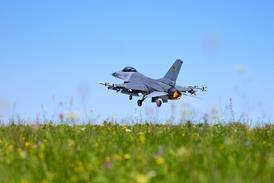RAFAEL IS IN talks with Raytheon which could lead to elements of the Israeli missile manufacturer's Python 4 agile short-range air-to-air dogfight missile being included in the US company's bid to replace US Air Force and Navy AIM-9 Sidewinder weapons.
Raytheon's bid to meet the US AIM-9X requirement is based around a 125mm-diameter airframe. It has also provided a "growth-option" design thought to be based on a 165mm-diameter weapon. Rafael could provide an "off-the shelf" motor for the bigger design. The additional propellant in a wider diameter missile would increase considerably the weapon's performance-envelope.
Rafael finally unveiled the configuration of its Python 4 at the Washington Convention. Previously, officially released images had omitted the forward ailerons and the rear-fuselage strengthening strakes.
Rafael confirms that it is in discussions with Raytheon over the Python 4 motor, which is already in service with the Israel air force.
The solid-propellant dual-thrust motor, the ND-10, has a profiled motor burn to allow the missile to be used against high off-boresight targets.
After an initial high-thrust burning of some 8kN (1,800lb) for 3-4s, the missile motor's thrust is reduced to around 0.7kN for up to a further 80s. A moderate increase in thrust to provide manoeuvring energy could also be expected.
Raytheon is competing with Hughes for the AIM-9X contract. The latter is offering an "in-house" bid based on the Box Office air frame and also a modified British Aerospace Advanced Short Range Air-to-Air Missile (ASRAAM).
The improved ASRAAM P3I differs from the baseline design by including thrust-vector control and an increased warhead size.
BAe's ASRAAM has also been evaluated separately under a foreign-comparative test (FCT) programme. An otherwise successful evaluation was marred when the final missile shot from a ground sled resulted in it breaking up around 4s into the flight.
Sources say that the sled test was intended to examine the missile's performance at a 30¡ angle of attack (AoA). The weapon was launched and flown at this AoA, successfully completing a maximum G turn before the failure occurred. The cause of the failure has yet to be determined.
The US Department of Defense will announce the winner of the AIM-9X competition around the turn of the year, with a initial production run of 5,000 missiles each for the air force and navy.
Source: Flight International




















